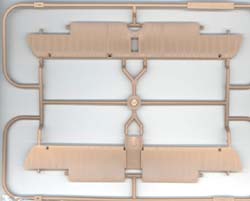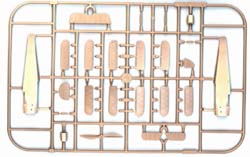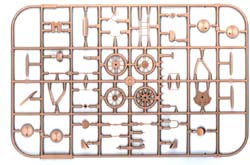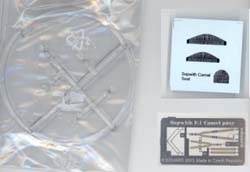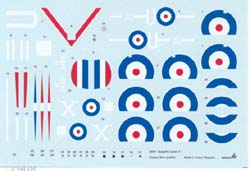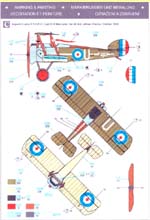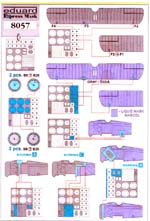Eduard 1/48 Sopwith F.1 Camel | 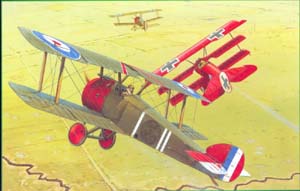 | History Today the Camel is the best known of WWI fighters; thanks more to Snoopy than to the heroic exploits of "Aces" Captain Roy Brown, Major W.G. Barker, Colonel Raymond Collishaw, et al. Thanks also to Snoopy, the Fokker Dr.I Triplane of the "cursed Red Baron" is the second best known fighter from the Great War. We cognoscenti have, however, other - more serious (?) - reasons for knowing about these planes but we should be grateful for this gratuitous notoriety. Chronologically, the Camel was T. O. M. Sopwith's fifth fighter in his WWI series of Baby, 1 1/2 Strutter, Pup, Triplane, Camel, Dolphin, Snipe and Salamander. His Hippo, Bulldog, Rhino, Snail, Snark, Snapper and Swallow of the same period were experiments that saw neither production nor wartime service. Incredibly, especially in light of today's extremely long periods of development, most of Sopwith's WWI airplanes proceeded from sketch to release for squadron service, or cancellation, in six or seven months! Although the Camel followed the Triplane in Sopwith's line of succession it was really a follow-on development of the Pup. To make the Camel as nimble as possible Sopwith's designers grouped all of the plane's main masses - engine, fuel, oil, pilot, weapons, ammunition and undercarriage - close to the center of gravity giving it a very low polar moment of inertia; rather like a current mid-engined race car. This resulted in vicious responsiveness, which in capable hands made it a formidable dogfighter. Horsepower for production Camels ranged from 110 to 170; provided by nine cylinder rotaries from engine makers Clerget, LeRhone, Gnome and Bentley. These powerful rotaries, placed so close to the center of gravity, made the Camel's handling unlike anything flown before. The plane could turn more sharply and quickly than any other. Due, however, to the combination of torque reaction and gyroscopic effects the nose would drop in a right turn and rise in a left turn requiring application of left rudder in both cases. If you've ever flown, you'll know this quirk would take some getting used to! 5,600 F.1 and 285 2F.1 Camels were built by Sopwith and 14 other manufacturers during WWI. Some continued in service with Commonwealth and foreign air forces into the mid 1920s. The Kit Finally, a really good 1:48 scale Camel kit at a "reasonable" price. This new kit by Eduard is far superior to the Blue Max F.1/2F.1 kit of 1998. The stout enough, lidded box encloses four sprue trees of light brown polystyrene containing 72 crisply detailed injection molded parts along with five clear inspection windows for the wings, plus a photo-etched fret of six pre-painted parts, a set of painting masks, a decal sheet and a folder of instructions. What more can the Profipack version possibly have? Engineering of the kit is conventional with the fuselage in the customary halves and the wings and tail components molded as one piece units. A great leap forward in kit engineering is scored by Eduard in this kit by the provision of all of the control surfaces as separate parts - they even provide separate control horns! Great! I hope that all other kit manufacturers adopt this highly desirable feature. Optional parts for the three color/markings schemes are included and it is obvious that Eduard is planning to release a 2F.1 as a follow-on to this initial issue of the F.1. An interesting and unusual feature of Eduard's packaging of this kit is the provision of three pegs that plug together to hold the A and B sprue trees at a small distance from one another to minimize damage to the boxed parts. Sprue trees C and D, puzzlingly, don't have this commendable feature. If they carry this idea a skosh further the generally less than adequate boxing could be compensated for - probably at no increase in manufacturing costs. The fuselage interior is pretty well detailed but not so much that it can't be improved upon. The engine is also well detailed; Eduard even provide separate moldings for the intake and exhaust valve pushrods, which locates them correctly in two separate planes rather than in one plane as is usually the case. The plastic pushrods are, though, a bit oversize and fragile (a couple of mine were pre-broken) and should be replaced with straight wire of the correct diameter. The kit's engine installation is engineered so that it rotates as a unit with the propeller as a rotary should. The decal sheet is well printed in perfect register and the roundel blue is the correct light shade for the period. Small stenciling, individual instrument faces and Sopwith logos are included. The kit's three color/markings schemes are for Camel F.1s: € B7270 of Captain Roy Brown, 209 Squadron, Bertangles, France, April 1918. [EDITOR'SNOTE: This aircraft actually used the Bentley AR engine and had a different cowl than that inclued in the kit - RNP] € B2455 of Lieutenant E.G. Forder, 28 Squadron, Italy, May 1918 and € F2137 of Captain D. R. MacLaren, 46 Squadron, Athies, France, October 1918. Something new in the use of decals is an "open" black patterned set of decals to be applied over the light amber-brown painted seat to provide the appearance of the voids and shadows of wicker work - interesting. The instruction folder is made up of three and a half sheets of A-4 size paper presenting general instructions, a parts map, a 10 step assembly sequence and four pages of color and markings guidance. The color schemes are printed in color. I believe this is a first, and a nice one, for Eduard. These instructions also present two good, easily read, rigging diagrams. Conclusion A truly fine kit. I had ordered the Profipack version but my connection - Emil Meinerich's Skyways Model Shop in south Seattle received only these regular issue kits priced at $32.95. Without seeing it, I can't imagine the Profipack having enough needed extras to make it worth its, undoubtedly, greater price. This kit is complete and it is generally well engineered save for upper wing and undercarriage installation and alignment. This is the next area of engineering improvement for all kit manufacturers. Please guys, look at the old Monogram, Matchbox and Hasegawa bipes as well as the newer Accurate Miniatures and Tamiya Grummans and Swordfish and go and do similarly with biplane wings and undercarriages. You'll increase your sales by making biplanes easier for the average, casual, modeler to build. I especially appreciate Eduard's making all of the control surfaces separate. I believe this is the first mass produced modern kit in general distribution to have this highly desirable feature. Thank you Eduard for a great kit. Please give us more and extend this kit's virtues to your 1:72 scale offerings. Tamiya - watch out; they're gaining on you! References € Windsock DataFile 26: J.M. Bruce, Albatros Productions, UK. € War Planes Of The First World War - Fighters, Vol. 2: J. M. Bruce, MacDonald, London, 1968, ISBN: 356-01473-8. € Sopwith Aircraft: Mick Davis, Crawford Press, UK, 1999, ISBN: 1-86126-2175. € Sopwith Fighters - In Action No. 110: Squadron Signal, USA. € Profile No.31: J. M. Bruce. There are, of course, many more Camel references but these will suffice. | 








|

